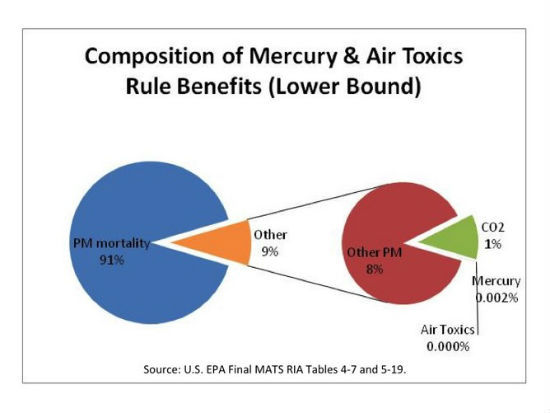
A thoughtful new analysis of the benefits of reducing public exposure to mercury adds to several studies suggesting that whatever it costs to make those cuts, either under the U.S. Mercury and Air Toxics Rule (MATS) or the international Minamata Convention, it's worth doing. But like that entire body of work, this new analysis is based on a controversial assumption about just how much harm mercury does in the first place. It turns out that this widely known and feared environmental bogeyman might not be as serious a danger as this new study suggests, which the environmental and science media are mostly failing to report.
The study, by Amanda Giang and Noelle Selin of MIT, (summarized for non-academic speakers here, in full here) adds up all the health damage mercury is believed to do and assigns a dollar value to that harm. The study estimates that the cumulative value of the direct health benefits in the United States from the "Minamata" reductions total is a whopping
$339 billion (2005 USD), with a range from $1.4 billion to $575 billion in our sensitivity scenarios.
It also estimates the value to the U.S. economy from reducing the productivity losses caused when mercury pollution makes workers sick.
Cumulative economy-wide benefits to the United States, realized by 2050, are $104 billion, with a range from $6 million to $171 billion.
And compared to achieving reductions the "Minamata' way, the study says the value of the U.S. mercury rule is ten times greater.
That's a pretty persuasive case that mercury is really bad for us, and that reducing exposure, which comes mostly from seafood, would do us a lot of good. Unfortunately, that case rests on really shaky foundations. It makes a critical assumption that mercury causes cardiovascular problems, particularly heart attacks, even thought that assumption is directly contradicted by several careful epidemiological studies. It is fair to say that there is a lot of disagreement and uncertainty in the epidemiological community about the connection between mercury and cardiovascular risk.
Giang and Selin make only a brief mention of that uncertainty in their main paper, and assume that the risk is real. Which doesn't seem honest, since the vast majority of their economic benefit from reduced mercury pollution comes from reduced cardiovascular risk. If that risk doesn't exist, their whole thesis is shot. They do acknowledge the controversy, but buried in an Appendix, where they acknowledge
there is substantial uncertainty surrounding the cardiovascular effects of methylmercury
and
The number of epidemiological studies addressing the cardiovascular impacts of mercury is relatively small
and
results from these studies have been inconsistent, with some studies finding positive associations between methylmercury exposure and cardiovascular disease, and others finding no association.
Giang and Selin mostly cite studies that support the belief that mercury raises cardiovascular risk. They fail to cite several that explicitly find there is no link between mercury and cardiovascular disease.
Mercury exposure and risk of cardiovascular disease in two U.S. cohorts found
no evidence of any clinically relevant adverse effects of mercury exposure on coronary heart disease, stroke, or total cardiovascular disease in U.S. adults at the exposure levels seen in this study.
Our findings do not support an association between total mercury exposure and the risk of coronary heart disease, but a weak relation cannot be ruled out.
With all that solid evidence undermining their central thesis. how do Giang and Selin justify their assumption of the link? They seem to rest their case on the fact that the EPA held a recent workshop to take the possibility of this risk seriously. But even the EPA says the link is speculative. When the agency did its own cost benefit evaluation of its mercury rule, it did NOT calculate the benefits of cardiovascular risk reduction, because to them, the evidence of the link just isn't solid enough.
The chart below illustrates what the EPA's own economic evaluation of its MATS rule found. Because they don't include the cardiovascular benefits, the reduction in mercury is a miniscule part of the overall benefit, which mostly comes from reducing other more harmful pollutants.
But what about the danger of mercury as a neurotoxin? Both the EPA and the Giang - Selin study also calculate the benefit of lowering mercury pollution and thus reducing the harm it does to the neural health of fetuses and infants. But both analyses find that this economic benefit is tiny, because all the research that identifies mercury as a neurotoxin has found that, at the levels the public is exposed to, mercury does very little harm to the fetus, less than one quarter of 1 IQ point and similar other minor cognitive deficits (measured when the children grow older). And that harm is counterbalanced by the benefits for healthy neural fetal from pregnant moms eating the fish. (The fatty acids in the fish help create cells that insulate the wiring connecting neurons in the developing fetal brain.) The neurotoxic risks to the public of mercury in seafood are miniscule. Giang and Selin's numbers, and the EPA's numbers, agree.
Have you read anything about any of this? Probably not. Not about the low level of harm that even high doses of mercury - via seafood exposure - actual does. Not about the big doubts about whether mercury causes any cardiovascular risk at all. What you probably have heard is that mercury is a dangerous neurotoxin and associated with cardiovascular disease and heart attacks, without any of the critical qualifications that put the risk in perspective.
That's in part because the news media is fed a constant diet of research findings supporting that more alarmist perspective, like the Giang and Selin study... a careful and thoughtful piece of work, but another academic shot in the Mercury War between those who play up the danger of mercury, and the public health researchers who take a more cautious view of the evidence. Research like the Giang-Selin study, that feeds the accepted wisdom about the danger of mercury, gets reported way more than findings that challenge that accepted wisdom and puts the known risks of mercury in perspective. Stories about scientific controversy don't attract too many readers. Stories about fear and danger do.
As a result the public is under-informed, and more fearful of mercury than the evidence appears to justify. And that fear does actual harm, because lots of people who are scared of mercury don't eat as much seafood, and miss out on the benefits of that food. Ironically these are lost cardiovascular benefits from the fatty acids in the fish, benefits that for nearly everyone outweigh mercury's risks.
It's hard enough for people to overcome all the inherent emotions and instincts that shape our perceptions of risk and make us more worried about some threats than we need to be, and less worried about some than we ought to be. It's a whole lot harder when academics are selective with the evidence, and when the journalists we rely on to keep us fairly and fully informed, don't.

